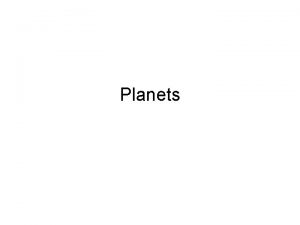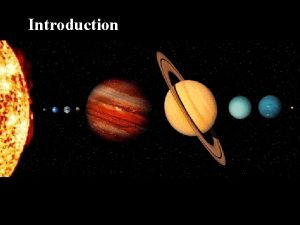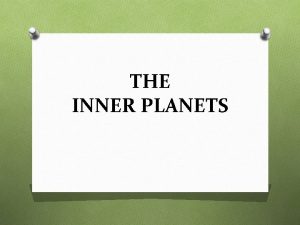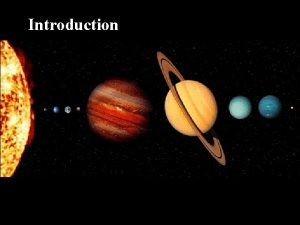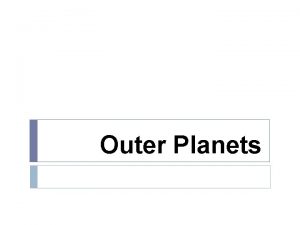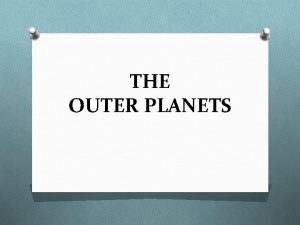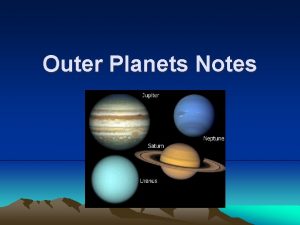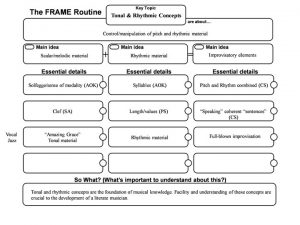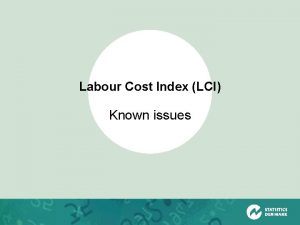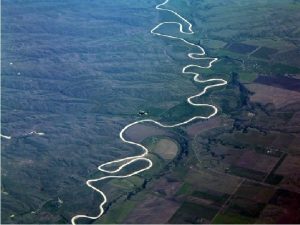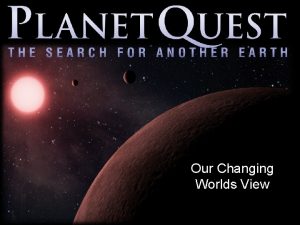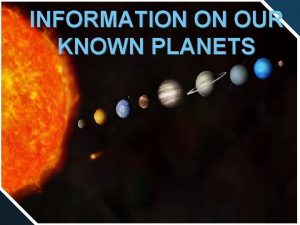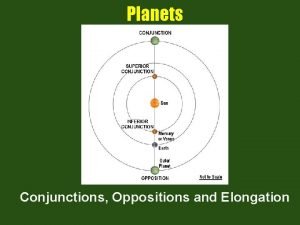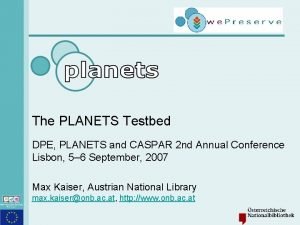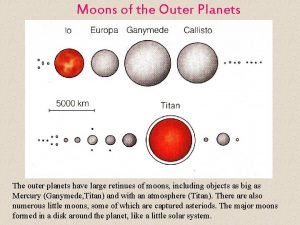PLANETS LO I will identify the known planets




























- Slides: 28

PLANETS LO: I will identify the known planets of the solar system.

SOLAR SYSTEM: all of the planets, moons, comets, and rocks that travel around the Sun GALAXY: giant collection of gas, dust, and trillions of stars Milky Way: our galaxy

Planet Sizes

PLANETS LO: I will identify the known planets of the solar system.

Universe: "the whole thing" huge space that contains all of the matter & energy in existence Contains: stars, planets, moons, meteors, asteroids, comets, space Formed from clouds of ice, gas, and dust Space never ends Our solar system makes up a very small part of universe Closest star to our solar system is the sun

SOLAR SYSTEM: all of the planets, moons, comets, and rocks that travel around the Sun GALAXY: giant collection of gas, dust, and trillions of stars Milky Way: our galaxy

MERCURY closest to the Sun circles Sun faster than other planets 36 million miles from sun Temp: day 6450 F, night 2000 F below zero looks like Moon, craters & volcanos no moons of its own tiny 3, 000 miles in diameter revolves around sun fast: 88 days = 1 year on Earth rotates very slow: 1 day = 59 Earth days crater: hole caused by an object hitting the surface of a planet or moon

VENUS losest planet to Earth, 6 million miles away rightest planet in our sky 7 million miles from Sun 7, 500 miles diameter surrounded by thick cold clouds most atmosphere is carbon dioxide 7000 F spins slowly backwards - takes 243 days for 1 rotation 225 days to circle Sun very plain, no mountains and almost no water named for Roman goddess of beauty although it's not pretty does not have a moon

EARTH: THE BLUE PLANET 3/4 surface covered with water Pacific Ocean is larger than all the land forms 7 great masses, continents are slowly drifting has atmosphere containing nitrogen, oxygen, & carbon dioxide people need oxygen to breathe, plants need carbon dioxide to breathe 4. 6 billion years old revolves around Sun once in 365 days 93 million miles from Sun rotates counter-clockwise once in 24 hours 7, 926 miles in diameter; medium sized only planet with life as we know it

MARS: THE RED PLANET covered with red rocks; dust storms give it color 1 day is 1/2 hour longer than Earth Martian year = 2 Earth years 2 tiny moons 141. 5 miles from Sun 1500 F below zero at night, 00 F in day 4, 215 miles in diameter, smaller than Earth a mountain on Mars is 3 times taller than tallest one on Earth giant canyon runs for thousands of miles evidence of places where long rivers once flowed atmosphere like Earth's; carbon dioxide and oxygen; air too th for us to breathe spacecraft landed in 1970's and 1997; soil samples showed there was no life as we know it on Earth

JUPITER THE GIANT largest planet 88, 700 in diameter 1, 300 Earth's could fit inside Jupite very bright, shines white light & can be seen in southern night sk just before/after midnight full of colors, has yellow, brown, & red clouds huge red spot just below equator is raging lightening & wind stor twice the size of Earth has many moons 1 day on Earth = 10 hours on Jupiter 1 year on Jupiter = 12 years on Earth 483. 3 miles from Sun yet very hot because heat comes from insid the planet

SATURN famous for its bright, oval rings hundreds of rings packed closely together rings are chunks of ice & rock 75, 000 miles in diameter, huge very light, could float in the ocean made of hot gases with thick core of solid matter Saturn tilts like Earth so has 4 seasons 1 day on Saturn = 10 hours on Earth 1 year on Saturn = 29 1/2 Earth years 886, 000 miles from Sun bad weather all of the time, storms give it a yellow/tan color in one place there is bright, pink spot, a storm at least 23 moons circle Saturn one moon is pitch black on one side and snow white on other another moon, Titan, is second biggest moon

URANUS first seen by telescope in 1781 farthest planet seen with naked eye 1, 778, 000 miles from Sun very cold, never more than 3100 F below zero 1 Uranus year = 84 Earth years 1 Uranus day = 11 hours on Earth 1970's was discovered that Uranus has rings like Saturn, nin visible 30, 900 miles in diameter, 4 times larger than Earth Uranus lies on its side, spinning like a bowling ball speeds up and slows down due to Neptune's gravitational pu it has 15 moons orbiting around its center, like spokes on a wheel

NEPTUNE discovered in 1846, 2 billion miles from Sun named for ancient god of the seas has 2 main rings & 3 smaller rings cannot be seen with the naked eye blue-green color, details of surface are not visible Neptune's gravitational pull on Uranus causes Uranus to speed up and slow down 32, 900 miles in diameter, same size as Uranus 8 moons and many "moonlets" in Neptune's rings 1 day on Neptune = 16 Earth hours 1 year on Neptune = 165 Earth years freezing cold, warmest day is 3600 F below zero frozen ammonia clouds circle planet beneath clouds, poison gases fill atmosphere constant violent storms Voyager 11 spacecraft passed by and took pictures

IS PLUTO A PLANET? "dwarf-planet" 1 billion miles past Neptune 3, 660, 000 miles from Sun; no other planet is as far from Sun Pluto found in 1930 because it was pulling Neptune out of orbit can only guess what it's like must be ice cold with solid, dense center, may have one moon think it's 2, 000 miles in diameter, smallest planet & is why we now call it a dwarf planet takes 248 Earth years for Pluto to orbit once around the Sun 1 day = 6 Earth days off center orbit sometimes brings Pluto closer to Sun than Neptune

INNER PLANETS: Mercury, Venus, Earth, and Mars Smaller and made of mostly rock and iron OUTER PLANETS: Jupiter, Saturn, Uranus, and Neptune Larger and made mostly of hydrogen, helium and ice

SATURN famous for its bright, oval rings hundreds of rings packed closely together rings are chunks of ice & rock 75, 000 miles in diameter, huge very light, could float in the ocean made of hot gases with thick core of solid matter Saturn tilts like Earth so has 4 seasons 1 day on Saturn = 10 hours on Earth 1 year on Saturn = 29 1/2 Earth years 886, 000 miles from Sun bad weather all of the time, storms give it a yellow/tan color in one place there is bright, pink spot, a storm at least 23 moons circle Saturn one moon is pitch black on one side and snow white on other another moon, Titan, is second biggest moon

MERCURY closest to the Sun circles Sun faster than other planets 36 million miles from sun Temp: day 6450 F, night 2000 F below zero looks like Moon, craters & volcanos no moons of its own tiny 3, 000 miles in diameter revolves around sun fast: 88 days = 1 year on Earth rotates very slow: 1 day = 59 Earth days crater: hole caused by an object hitting the surface of a planet or moon

VENUS losest planet to Earth, 6 million miles away rightest planet in our sky 7 million miles from Sun 7, 500 miles diameter surrounded by thick cold clouds most atmosphere is carbon dioxide 7000 F spins slowly backwards - takes 243 days for 1 rotation 225 days to circle Sun very plain, no mountains and almost no water named for Roman goddess of beauty although it's not pretty does not have a moon

EARTH: THE BLUE PLANET 3/4 surface covered with water Pacific Ocean is larger than all the land forms 7 great masses, continents are slowly drifting has atmosphere containing nitrogen, oxygen, & carbon dioxide people need oxygen to breathe, plants need carbon dioxide to breathe 4. 6 billion years old revolves around Sun once in 365 days 93 million miles from Sun rotates counter-clockwise once in 24 hours 7, 926 miles in diameter; medium sized only planet with life as we know it

MARS: THE RED PLANET covered with red rocks; dust storms give it color 1 day is 1/2 hour longer than Earth Martian year = 2 Earth years 2 tiny moons 141. 5 miles from Sun 1500 F below zero at night, 00 F in day 4, 215 miles in diameter, smaller than Earth a mountain on Mars is 3 times taller than tallest one on Earth giant canyon runs for thousands of miles evidence of places where long rivers once flowed atmosphere like Earth's; carbon dioxide and oxygen; air too th for us to breathe spacecraft landed in 1970's and 1997; soil samples showed there was no life as we know it on Earth

Jupiter's Spot

JUPITER THE GIANT largest planet 88, 700 in diameter 1, 300 Earth's could fit inside Jupite very bright, shines white light & can be seen in southern night sk just before/after midnight full of colors, has yellow, brown, & red clouds huge red spot just below equator is raging lightening & wind stor twice the size of Earth has many moons 1 day on Earth = 10 hours on Jupiter 1 year on Jupiter = 12 years on Earth 483. 3 miles from Sun yet very hot because heat comes from insid the planet

URANUS first seen by telescope in 1781 farthest planet seen with naked eye 1, 778, 000 miles from Sun very cold, never more than 3100 F below zero 1 Uranus year = 84 Earth years 1 Uranus day = 11 hours on Earth 1970's was discovered that Uranus has rings like Saturn, nin visible 30, 900 miles in diameter, 4 times larger than Earth Uranus lies on its side, spinning like a bowling ball speeds up and slows down due to Neptune's gravitational pu it has 15 moons orbiting around its center, like spokes on a wheel

NEPTUNE discovered in 1846, 2 billion miles from Sun named for ancient god of the seas has 2 main rings & 3 smaller rings cannot be seen with the naked eye blue-green color, details of surface are not visible Neptune's gravitational pull on Uranus causes Uranus to speed up and slow down 32, 900 miles in diameter, same size as Uranus 8 moons and many "moonlets" in Neptune's rings 1 day on Neptune = 16 Earth hours 1 year on Neptune = 165 Earth years freezing cold, warmest day is 3600 F below zero frozen ammonia clouds circle planet beneath clouds, poison gases fill atmosphere constant violent storms Voyager 11 spacecraft passed by and took pictures

IS PLUTO A PLANET? "dwarf-planet" 1 billion miles past Neptune 3, 660, 000 miles from Sun; no other planet is as far from Sun Pluto found in 1930 because it was pulling Neptune out of orbit can only guess what it's like must be ice cold with solid, dense center, may have one moon think it's 2, 000 miles in diameter, smallest planet & is why we now call it a dwarf planet takes 248 Earth years for Pluto to orbit once around the Sun 1 day = 6 Earth days off center orbit sometimes brings Pluto closer to Sun than Neptune

INNER PLANETS: Mercury, Venus, Earth, and Mars Smaller and made of mostly rock and iron OUTER PLANETS: Jupiter, Saturn, Uranus, and Neptune Larger and made mostly of hydrogen, helium and ice

 The inner solar system by leslie
The inner solar system by leslie Inner terrestrial planets
Inner terrestrial planets Four outer planets in order
Four outer planets in order Why do jovian planets have rings
Why do jovian planets have rings What separates the inner planets and outer planets
What separates the inner planets and outer planets Các môn thể thao bắt đầu bằng từ đua
Các môn thể thao bắt đầu bằng từ đua Tư thế ngồi viết
Tư thế ngồi viết Hình ảnh bộ gõ cơ thể búng tay
Hình ảnh bộ gõ cơ thể búng tay Cái miệng nó xinh thế
Cái miệng nó xinh thế Mật thư tọa độ 5x5
Mật thư tọa độ 5x5 Tư thế ngồi viết
Tư thế ngồi viết Thế nào là giọng cùng tên?
Thế nào là giọng cùng tên? Gấu đi như thế nào
Gấu đi như thế nào Thẻ vin
Thẻ vin Thơ thất ngôn tứ tuyệt đường luật
Thơ thất ngôn tứ tuyệt đường luật Sự nuôi và dạy con của hổ
Sự nuôi và dạy con của hổ Từ ngữ thể hiện lòng nhân hậu
Từ ngữ thể hiện lòng nhân hậu Thế nào là hệ số cao nhất
Thế nào là hệ số cao nhất Diễn thế sinh thái là
Diễn thế sinh thái là Vẽ hình chiếu vuông góc của vật thể sau
Vẽ hình chiếu vuông góc của vật thể sau Lp html
Lp html Phép trừ bù
Phép trừ bù Lời thề hippocrates
Lời thề hippocrates đại từ thay thế
đại từ thay thế Vẽ hình chiếu đứng bằng cạnh của vật thể
Vẽ hình chiếu đứng bằng cạnh của vật thể Tư thế worm breton là gì
Tư thế worm breton là gì Quá trình desamine hóa có thể tạo ra
Quá trình desamine hóa có thể tạo ra Công thức tính thế năng
Công thức tính thế năng Khi nào hổ mẹ dạy hổ con săn mồi
Khi nào hổ mẹ dạy hổ con săn mồi





























